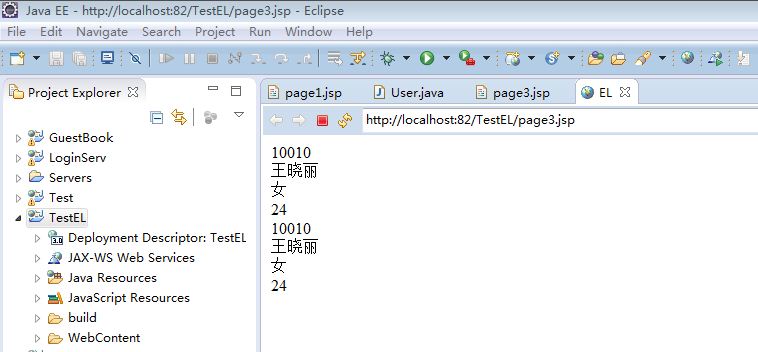表达式语言Expression Language
目的:简化jsp代码
EL内置对象
1、pageContext
2、pageScope
3、requestScope
4、sessionScope
5、applicationScpoe
6、param
7、paramValues
8、header
9、headerValues
10、cookie
11、initParam
示例1
<%@ page language="java" contentType="text/html; charset=utf-8"
pageEncoding="utf-8"%>
<!DOCTYPE html PUBLIC "-//W3C//DTD HTML 4.01 Transitional//EN" "http://www.w3.org/TR/html4/loose.dtd">
<html>
<head>
<meta http-equiv="Content-Type" content="text/html; charset=utf-8">
<title>EL表达式</title>
</head>
<body>
<%
pageContext.setAttribute("name", "Allen");
request.setAttribute("age",24);
session.setAttribute("sex","女");
application.setAttribute("cellphone",131);
%>
<h3>姓名:${name }</h3>
<h3>年龄:${age }</h3>
<h3>性别:${sex }</h3>
<h3>电话:${cellphone }</h3>
</body>
</html>

//寻找值的顺序 //page>request>session>application
当pageContext、request、session、application都设计键为name是,值value是谁的呢?
验证寻找顺序:
<%
pageContext.setAttribute("name", "Allen");
request.setAttribute("name",24);
session.setAttribute("name","女");
application.setAttribute("name",131);
%>
<h3>姓名:${name }</h3>

【EL表达式接受请求参数】
<%@ page language="java" contentType="text/html; charset=utf-8"
pageEncoding="utf-8"%>
<!DOCTYPE html PUBLIC "-//W3C//DTD HTML 4.01 Transitional//EN" "http://www.w3.org/TR/html4/loose.dtd">
<html>
<head>
<meta http-equiv="Content-Type" content="text/html; charset=utf-8">
<title>EL表达式</title>
</head>
<body>
<%-- post提交 --%>
<form method="post" action="target.jsp">
<input type="text" name="userName" />
<input type="submit" value="提交到target.jsp">
</form>
<%-- get提交 --%>
<a href="target.jsp?age=24">get提交</a>
<%-- post提交多个参数 --%>
<form method="post" action="target.jsp">
<input type="checkbox" name="instr" value="登山" />登山
<input type="checkbox" name="instr" value="滑雪" />滑雪
<input type="checkbox" name="instr" value="骑行" />骑行
<input type="checkbox" name="instr" value="游泳" />游泳
<input type="submit" value="提交到target.jsp">
</form>
</body>
</html>
<%@ page language="java" contentType="text/html; charset=utf-8"
pageEncoding="utf-8"%>
<!DOCTYPE html PUBLIC "-//W3C//DTD HTML 4.01 Transitional//EN" "http://www.w3.org/TR/html4/loose.dtd">
<html>
<head>
<meta http-equiv="Content-Type" content="text/html; charset=utf-8">
<title>target</title>
</head>
<body>
<% request.setCharacterEncoding("utf-8"); %>
<h3>姓名:${param.userName }</h3>
<h3>年龄:${param.age }</h3>
<h3>兴趣1:${paramValues.instr[0] }</h3>
<h3>兴趣2:${paramValues.instr[1] }</h3>
<h3>兴趣3:${paramValues.instr[2] }</h3>
<h3>兴趣4:${paramValues.instr[3] }</h3>
</body>
</html>
【对象操作】简单java类不用page引入,使用JavaBean
<%@ page language="java" contentType="text/html; charset=utf-8"
pageEncoding="utf-8"%>
<!DOCTYPE html PUBLIC "-//W3C//DTD HTML 4.01 Transitional//EN" "http://www.w3.org/TR/html4/loose.dtd">
<html>
<head>
<meta http-equiv="Content-Type" content="text/html; charset=utf-8">
<title>EL</title>
</head>
<body>
<jsp:useBean id="user" scope="page" class="com.zhiqi.model.User"></jsp:useBean>
<jsp:setProperty property="id" name="user" value="10010"></jsp:setProperty>
<jsp:setProperty property="name" name="user" value="王晓丽"></jsp:setProperty>
<jsp:setProperty property="sex" name="user" value="女"></jsp:setProperty>
<jsp:setProperty property="age" name="user" value="24"></jsp:setProperty>
<jsp:getProperty name="user" property="id"></jsp:getProperty><br>
<jsp:getProperty name="user" property="name"></jsp:getProperty><br>
<jsp:getProperty name="user" property="sex"></jsp:getProperty><br>
<jsp:getProperty name="user" property="age"></jsp:getProperty><br>
<%--EL 与JavaBean比较 --%>
${user.id }<br><%--EL对象操作 --%>
${user.name }<br>
${user.sex }<br>
${user.age }<br>
</body>
</html>

【运算符操作】
<%@ page language="java" contentType="text/html; charset=utf-8"
pageEncoding="utf-8"%>
<!DOCTYPE html PUBLIC "-//W3C//DTD HTML 4.01 Transitional//EN" "http://www.w3.org/TR/html4/loose.dtd">
<html>
<head>
<meta http-equiv="Content-Type" content="text/html; charset=utf-8">
<title>EL运算符操作</title>
</head>
<body>
<% request.setAttribute("x", 10); %>
<% request.setAttribute("y", 4); %>
<%--算数四则原酸--%>
${x+y }<br>
${x-y }<br>
${x*y }<br>
${x/y }<br>
${x%y }<br>
<% request.setAttribute("z", true); %>
<% request.setAttribute("fal", false); %>
<%--布尔运算 --%>
${z }<br>
${!z }<br>
${z && fal }<br>
${z || fal }<br>
<%--空判断 --%>
空判断:${empty z }<br>
<% request.setAttribute("z", ""); %>
空判断:${empty z }<br>
<%--三目运算 --%>
<h4>x与y的大小:${x>y? x:y }</h4>
</body>
</html>

【EL操作List】
<%@ page language="java" contentType="text/html; charset=utf-8"
pageEncoding="utf-8"%>
<%@page import="java.util.*" %>
<!DOCTYPE html PUBLIC "-//W3C//DTD HTML 4.01 Transitional//EN" "http://www.w3.org/TR/html4/loose.dtd">
<html>
<head>
<meta http-equiv="Content-Type" content="text/html; charset=utf-8">
<title>EL操作List</title>
</head>
<body>
<%
List l=new LinkedList();
l.add(0,"北京");
l.add(1,"上海");
l.add(2,"广州");
request.setAttribute("l",l);
%>
${l[0] }<br>
${l[1] }<br>
${l[2] }<br>
</body>
</html>

【补充】
转义的使用-数组的使用-禁用EL的方法
<%@ page language="java" contentType="text/html; charset=utf-8"
pageEncoding="utf-8"%>
<!DOCTYPE html PUBLIC "-//W3C//DTD HTML 4.01 Transitional//EN" "http://www.w3.org/TR/html4/loose.dtd">
<html>
<head>
<meta http-equiv="Content-Type" content="text/html; charset=utf-8">
<title>EL2</title>
</head>
<body>
<% request.setAttribute("userName","Anner"); %>
<p>转义如何使用</p>
${10+2 }<br>
${10+2 }<br>
${requestScope.userName }<br>
${requestScope.userName }<br>
<p>数组的使用</p>
<%
String [] str={"上海","南京","重庆","西安"};
request.setAttribute("str",str);
%>
${str[0] }<br>
${str['1'] }<br>
${str["2"] }<br>
${str[3] }<br>
<p>设定页面不适用EL,当使用其他与EL冲突的技术,可以这样做!</p>
<p>方法1:<%@ page isELIgnored="false" %> page指令设置为true</p>
<p>方法2:xml配置</p>
</body>
</html>
<?xml version="1.0" encoding="UTF-8"?>
<web-app>
<jsp-config>
<jsp-property-group>
<url-pattern>*.jsp</url-pattern>
<el-ignored>true</el-ignored>
</jsp-property-group>
</jsp-config>
</web-app>
【】